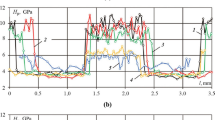Conclusions
-
1.
High-temperature mechanicothermal treatment at 900–1100\dgC with 12–15 and 25–28% reduction notably increases the strength characteristics of steel Kh18N10T but reduces the plasticity only slightly. The strength increases as the rolling temperature decreases and the degree of deformation increases.
-
2.
The thermal stability of the hardening resulting from HTMTT under conditions completely preventing recrystallization depends very little on the rolling temperature but mainly on the degree of reduction.
The thermal stability is highest after 12–15% reduction at 900–1000°C.
-
3.
The partial development of recrystallization during high-temperature deformation sharply reduces the thermal stability of the cold hardening resulting from HTMTT.
Similar content being viewed by others
Literature cited
M. L. Bernshtein, Thermomechanical Treatment of Metals and Alloys [in Russian], Vol. 1 Metallurgiya, Moscow (1968).
Additional information
Chelyabinsk Polytechnical Institute, Zlatoust Metallurgical Plant. Translated from Metallovedenie i Termicheskaya Obrabotka Metallov, No. 3, pp. 52–55, March, 1969.
Rights and permissions
About this article
Cite this article
Shteinberg, M.M., Smirnov, M.A., Tolstov, A.M. et al. Thermal stability of hardening of steel Kh18N10T resulting from mechanicothermal treatment. Met Sci Heat Treat 11, 217–219 (1969). https://doi.org/10.1007/BF00658737
Issue Date:
DOI: https://doi.org/10.1007/BF00658737



